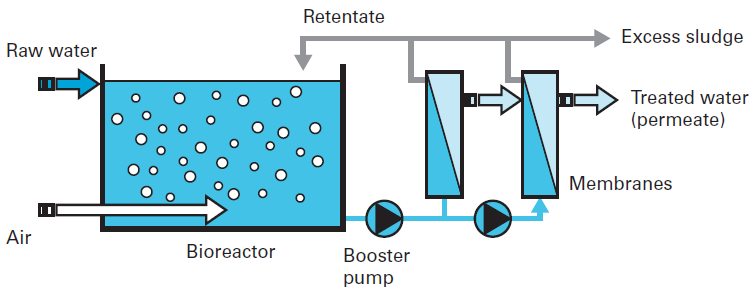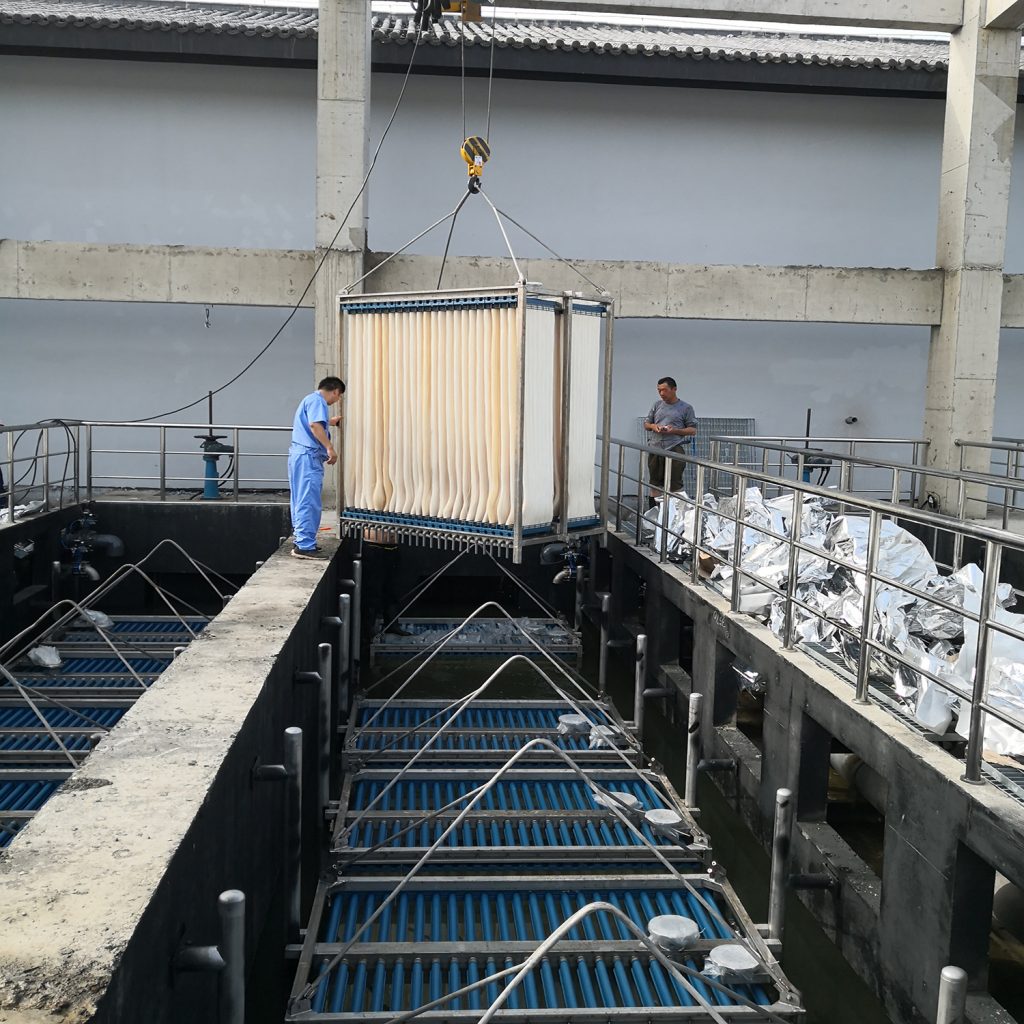Just How Membrane Layer Bioreactors Are Reinventing Water Filtration Solutions
The emergence of membrane layer bioreactors (MBRs) stands for a considerable development in the area of water purification, combining organic treatment procedures with innovative membrane filtering technologies. This combination not just enhances the top quality of treated effluent however additionally addresses urban area restraints, making MBRs especially ideal for densely inhabited locations. As international water scarcity intensifies, the duty of MBRs in facilitating drinkable water reuse and lasting water monitoring becomes progressively vital. The effects of this modern technology extend beyond efficiency-- what difficulties and chances exist in advance for its widespread implementation?
Introduction of Membrane Bioreactors
Membrane bioreactors (MBRs) stand for a considerable advancement in water purification modern technology, as they incorporate organic treatment procedures with membrane layer purification. This assimilation improves the efficiency of wastewater therapy by making use of bacteria to deteriorate organic contaminants while at the same time using semi-permeable membranes to different cured water from suspended virus and solids.
The MBR system usually contains an organic activator where the microbial population metabolizes contaminants, adhered to by a membrane purification system that keeps biomass and enables just clean water to pass through. This double functionality causes greater effluent high quality contrasted to traditional therapy techniques. MBRs can be run in both batch and continuous circulation modes, using flexibility in layout and application.
Additionally, MBRs are characterized by their small impact, making them suitable for city settings with room constraints. Membrane Bioreactor. They additionally enable the healing of water for reuse, thus adding to water sustainability campaigns. While MBR innovation has gotten appeal in industrial and community applications, its functional complexities and power needs necessitate cautious factor to consider during application. Overall, MBRs are at the leading edge of boosting water treatment efficiency and quality, showcasing the potential for ingenious remedies in ecological management.
Benefits of MBR Modern Technology
The assimilation of biological treatment with membrane filtration provides various benefits for water purification processes. One of the main benefits of Membrane layer Bioreactor (MBR) modern technology is its capacity to effectively remove both not natural and organic contaminants, resulting in top notch effluent. The membrane layers function as a physical barrier, protecting against put on hold solids and virus from travelling through, which boosts the general security and reliability of treated water.
Furthermore, MBR systems require a smaller impact contrasted to traditional treatment methods, allowing for more reliable room use. This small design is particularly advantageous in city setups where land is limited. MBRs additionally show operational flexibility, accommodating differing influent high qualities and flow prices without considerable efficiency degradation.
In addition, the procedure offers boosted nutrient removal capabilities, specifically for nitrogen and phosphorus, which are critical for protecting against eutrophication in getting waters. The reduced sludge manufacturing related to MBR modern technology likewise converts to decrease disposal prices, making it a cost-effective option over time - Membrane Bioreactor. In general, the benefits of MBR technology placement it as a leading option for lasting and innovative water filtration systems, addressing both ecological and financial issues
Applications in Water Purification
Applications of Membrane Layer Bioreactor (MBR) innovation in water filtration are impactful and diverse, resolving various treatment needs across numerous industries. MBRs successfully combine biological treatment procedures with membrane filtering, making them excellent for community wastewater treatment, commercial effluent monitoring, and even drinkable water reuse efforts.
In metropolitan setups, MBRs are progressively utilized to boost the high quality of treated wastewater, allowing for conformity with strict discharge guidelines and facilitating the recycling of water for watering and non-potable uses. Their portable style likewise makes them appropriate for urban atmospheres where space is restricted.
Industrially, MBR technology is used to treat process water and wastewater, particularly in fields such as food and beverage, drugs, and textiles. By effectively getting rid of contaminants and suspended solids, MBRs aid industries minimize environmental influences while recuperating beneficial sources from wastewater streams.
Furthermore, MBRs are acquiring grip in decentralized water treatment applications, where small-scale click to read more systems can be deployed in remote areas or establishing regions. This versatility enables areas to achieve sustainable water monitoring options, improving accessibility to tidy water while reducing dependence on traditional treatment techniques.
Study and Success Stories

In an additional instance, a textile production center in Bangladesh adopted MBR modern technology to resolve its wastewater obstacles. The system lowered chemical oxygen need (COD) levels from 1,200 mg/L to less than 100 mg/L, hence satisfying governing requirements and significantly reducing he has a good point ecological impact.
The University of Cape Town's MBR setup has shown reliable in dealing with greywater for non-potable reuse on campus. This task not just preserves drinkable water yet likewise acts as an educational version for sustainable techniques.
Furthermore, a seafood processing plant in Norway utilized MBR innovation to deal with effluents having high degrees of raw material, accomplishing over 90% contaminant elimination. These study highlight MBR innovation's flexibility and its essential role in improving water high quality throughout diverse applications.
Future of Water Therapy Solutions
As international water scarcity and pollution obstacles magnify, cutting-edge water treatment solutions are coming to be increasingly vital to make sure lasting accessibility to tidy water. The future of water therapy depends on the integration of innovative modern technologies that boost the performance and efficiency of filtration procedures. Membrane layer bioreactors (MBRs) go to the center of this development, integrating organic therapy with membrane filtration to generate premium effluent ideal for various applications.

Emerging trends such as source recuperation from wastewater, consisting of nutrients and energy, will additionally transform treatment facilities into eco-friendly centers. Additionally, improvements in nanotechnology and membrane layer materials promise boosted efficiency and longevity of filtration systems.

Final Thought
Their duty in safe and clean water reuse and lasting water management highlights their relevance in attending to global water scarcity difficulties. Continued check over here study and growth will further boost the effectiveness and adoption of MBR technology, ensuring a resistant future for water treatment solutions.
The introduction of membrane bioreactors (MBRs) stands for a significant innovation in the field of water filtration, merging organic treatment procedures with sophisticated membrane purification technologies. As international water scarcity magnifies, the function of MBRs in facilitating drinkable water reuse and sustainable water administration comes to be progressively important. They additionally enable the recovery of water for reuse, hence contributing to water sustainability efforts.As international water scarcity and contamination obstacles magnify, ingenious water therapy solutions are ending up being progressively essential to guarantee sustainable accessibility to tidy water. Their duty in safe and clean water reuse and sustainable water management highlights their significance in addressing global water scarcity difficulties.